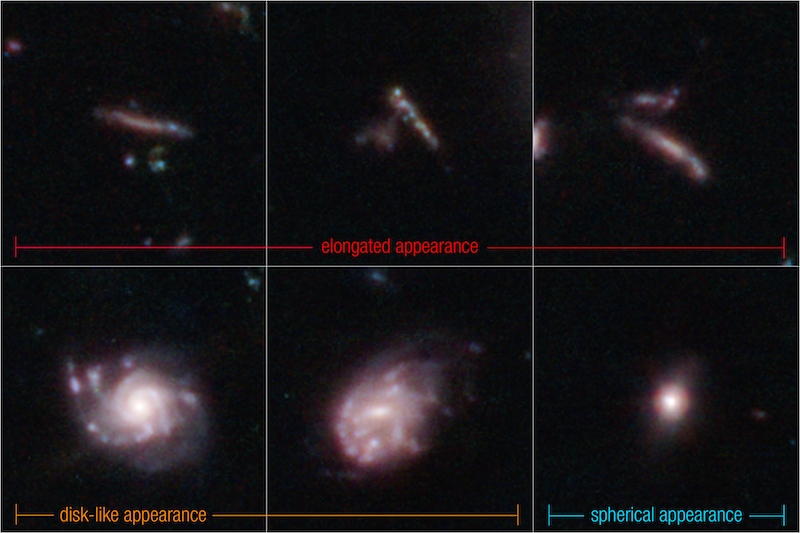
Was the early universe a big beach party? It would seem so, according to NASA’s James Webb Space Telescope. NASA said on January 17, 2024, that many of the early galaxies in the young universe didn’t look like the ones we see now, including our own Milky Way. Instead, the NASA scientists said, they resembled pool noodles, surfboards, frisbees and volleyballs. Surf’s up, y’all!
And they said the pool noodle and surfboard galaxies, in particular, were common when the universe was a lot younger.
The new paper has been accepted for publication in The Astrophysical Journal. Meanwhile, the international team of researchers published a preprint version of the paper on arXiv on October 23, 2023.
Majority of early galaxies looked like surfboards and pool noodles
When we look at older galaxies today – that is, those closer to us in space and therefore closer to us in time – we see that they are often circular. Generally speaking, they are like flattened disks, often with well-defined spiral arms. But the Webb telescope can study much younger galaxies, further away from us, back to when the universe was only hundreds of millions of years old (in contrast to its present age of some 13.7 billion years).
For this study, the researchers used data from Webb to examine galaxies 600 million to six billion years old. That’s still less than half the age of our present universe. The team used infrared images from NASA’s Cosmic Evolution Early Release Science (CEERS) Survey. And the researchers were able to quickly characterize many CEERS galaxies, by modeling their 3D geometries. That’s when they found something surprising.
That far back in time, most of the galaxies weren’t round, like the galaxies closer to us in space. Instead, these scientists said, they were flattened and elongated, resembling surfboards (oval) and pool noodles (prolate). As lead author Viraj Pandya at Columbia University in New York described them:
Roughly 50% to 80% of the galaxies we studied appear to be flattened in two dimensions. Galaxies that look like pool noodles or surfboards seem to be very common in the early universe, which is surprising, since they are uncommon nearby.
Other galaxies were indeed round, like volleyballs (spheroid) or frisbees (oblate). But these shapes were less common in the early universe.
Precursors to massive galaxies
The early galaxies not only looked different. They were also much less massive. In fact, they were the precursors to more massive galaxies that formed later, including our Milky Way. Co-author Kartheik Iyer, also at Columbia University, said:
In the early universe, galaxies had had far less time to grow. Identifying additional categories for early galaxies is exciting, there’s a lot more to analyze now. We can now study how galaxies’ shapes relate to how they look and better project how they formed in much more detail.
So what might our Milky Way have looked like, if we could see it as it was at that early age? Co-author Haowen Zhang at the University of Arizona in Tucson said:
Our best guess is that it might have appeared more like a surfboard.

Continuing the work of Hubble
The new observations by Webb build on previous ones by the Hubble Space Telescope. Hubble also viewed many early galaxies in the young universe, including elongated ones. In particular, its first Deep Field study in 1995 and later the Cosmic Assembly Near-infrared Deep Extragalactic Legacy Survey (CANDELS) FROM 2010-2013. These helped to improve statistics on early galaxies and create 3D models.
Now, Webb can see even farther back in time, to many of the most distant galaxies known. These are young galaxies that even Hubble couldn’t observe. As co-author Marc Huertas-Company at the Institute of Astrophysics on the Canary Islands, Spain, noted:
Hubble has long showed an excess of elongated galaxies. Webb confirmed that Hubble didn’t miss any additional features in the galaxies they both observed. Plus, Webb showed us many more distant galaxies with similar shapes, all in great detail.
But there’s still a lot of work to do, as co-author Elizabeth McGrath at Colby College in Waterville, Maine, explained:
These are early results. We need to delve more deeply into the data to figure out what’s going on, but we’re very excited about these early trends.
It’ll be interesting to see what even younger galaxies looked like. Were they surfboards and pool noodles too? Or something different?
Bottom line: NASA’s Webb space telescope has revealed that many early galaxies in the universe resembled surfboards and pool noodles in shape.
Via Webb Space Telescope (STScI)
Read more: Wow! Whirlpool galaxy in stunning new Webb images
Read more: Did Webb find signs of life on exoplanet K2-18 b?











